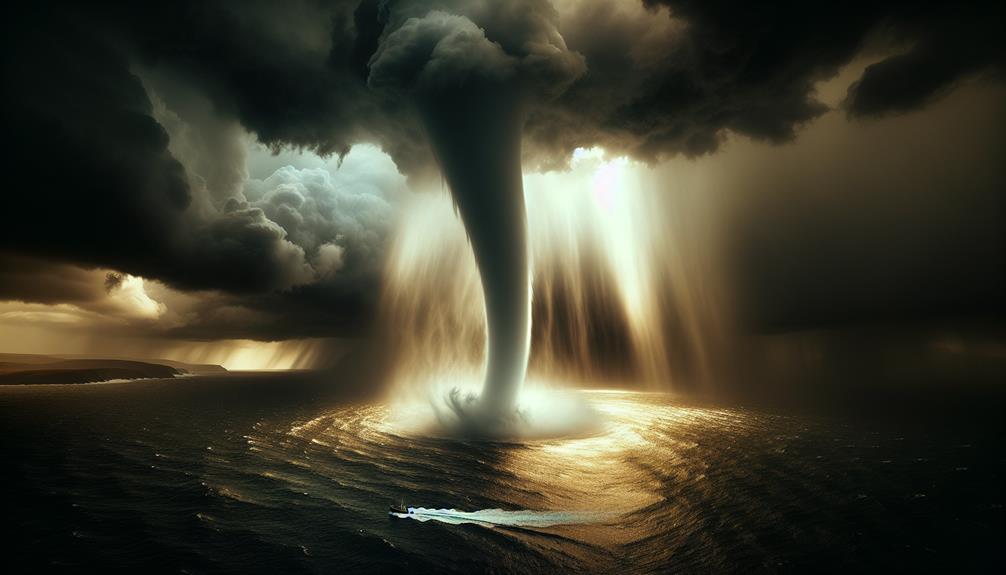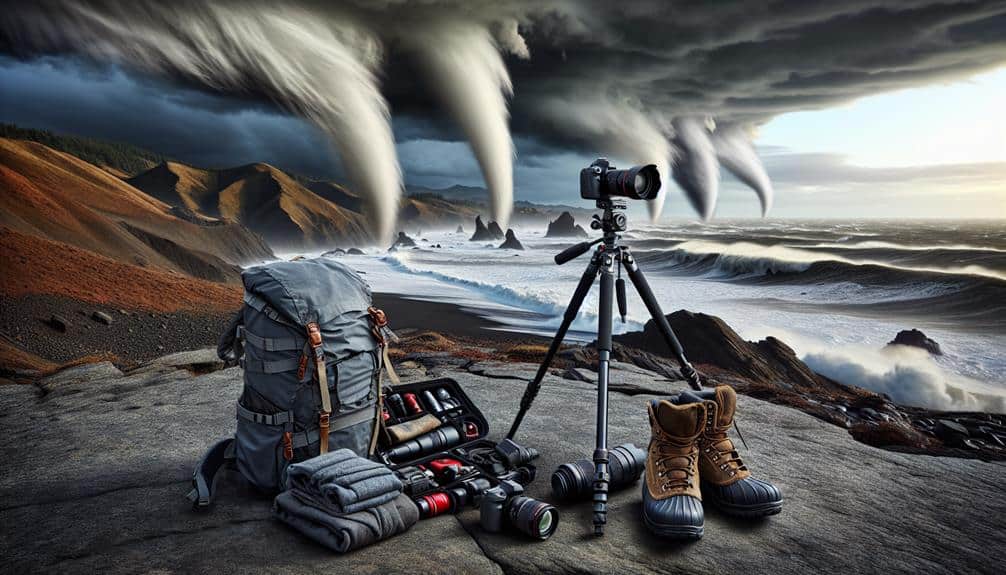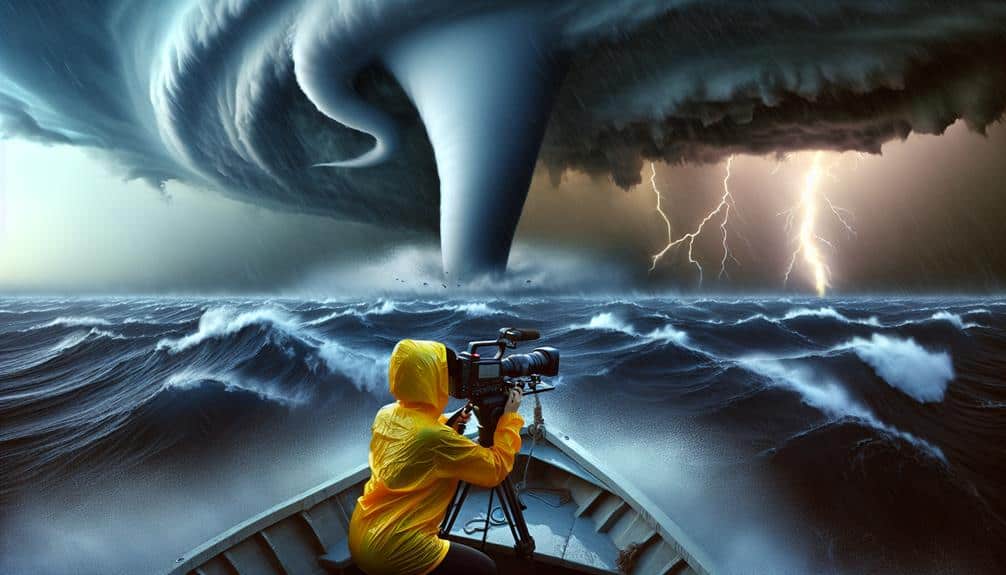We value high-quality waterspout photos because they improve our forecasting precision by revealing intricate weather patterns. These images, particularly when geotagged and time-stamped, enable us to pinpoint formation conditions and make immediate adjustments in weather advisories. They also contribute to scientific research by providing crucial visual evidence that enhances meteorological models. Capturing these distinctive moments enhances our credibility within the chasing community, demonstrating our commitment to accuracy and genuineness. Our ongoing emphasis on these essential photos guarantees we remain trusted and respected, providing deeper insights into atmospheric phenomena. Learn how these practices empower our chasing pursuits.
Key Points
- Waterspout photos provide critical visual evidence for scientific analysis and research on atmospheric phenomena.
- High-quality images enhance forecast accuracy by revealing complex weather patterns and favorable conditions for waterspout formation.
- Documenting waterspouts builds credibility and trust within the scientific community and among fellow chasers.
- Real-time photographic documentation aids in rapid information dissemination and collaborative analysis.
Documenting Phenomena
Documenting phenomena such as waterspouts requires not only the right equipment but also a keen understanding of meteorological conditions. By combining scientific documentation with visual evidence, we can capture the intricate dynamics of these natural events. High-resolution cameras, drones, and specialized software are essential tools. These allow us to gather precise data and imagery that contribute to our understanding of waterspouts.
Our primary objective is to make sure that the visual evidence we collect is both clear and scientifically valuable. To achieve this, we must be adept at interpreting weather patterns and predicting potential waterspout formations. Detailed logs of atmospheric conditions, including wind speed, humidity, and temperature, are vital. These records support the visual data, providing a thorough overview of the phenomenon.
Moreover, our documentation process involves real-time updates and rapid dissemination of information. By doing so, we enable other researchers and enthusiasts to analyze the data promptly. This collaborative approach not only enhances our knowledge but also fosters a sense of freedom and exploration among the community.
Essentially, our scientific documentation serves as a bridge, connecting raw data with visual evidence to deepen our collective understanding of waterspouts.
Enhancing Forecast Accuracy
To improve forecast precision, we must combine cutting-edge meteorological models with real-time data inputs from our field observations. By capturing high-definition photos of waterspouts, we gather invaluable data that unveils complex weather patterns. These images offer visual confirmation of atmospheric dynamics, which, when combined with meteorological models, enhance our predictive capabilities.
Our process commences with systematic data analysis of the photographs. Each image is geotagged and time-stamped, allowing accurate correlation with existing weather data. This thorough analysis helps pinpoint the specific conditions favorable for waterspout formation, such as wind shear, humidity levels, and temperature variances. By integrating these factors into our models, we enhance their dependability and precision.
Additionally, real-time data inputs from our observations enable us to adjust forecasts dynamically. When we spot a waterspout, we can relay this information immediately, triggering instant updates to weather advisories. This proactive method guarantees that forecasts remain up-to-date and exceptionally precise, offering the flexibility to prepare and respond efficiently.
Essentially, our fusion of field data with advanced modeling not only boosts forecast precision but also empowers individuals to make well-informed decisions based on accurate and timely weather predictions.
Contributing to Research
By systematically analyzing our waterspout photographs and integrating them into meteorological models, we can advance scientific research on atmospheric phenomena to a considerable extent. Our photographs serve as critical visual evidence, allowing scientists to perform detailed scientific analysis. These images offer a direct look at waterspout formation, structure, and dissipation, providing invaluable data that can refine existing theories and models.
Our role in data collection is indispensable for meteorological studies. Each photograph captures unique aspects of waterspouts, such as their size, duration, and interaction with surrounding weather systems. This granular level of detail is often unattainable through traditional observation methods alone. By contributing high-quality visual evidence, we enhance the precision of meteorological models, thereby improving our understanding of these complex phenomena.
Incorporating our visual data into broader meteorological studies allows researchers to identify patterns and correlations that might otherwise go unnoticed. This collaborative effort not only enriches the scientific community but also empowers us as chasers by validating our contributions to the field.
Ultimately, our meticulous documentation and submission of waterspout photographs play a pivotal role in advancing atmospheric science, providing a solid foundation for future research and innovation.
Building Credibility
Establishing our credibility as dependable contributors requires a commitment to consistently capturing high-quality, scientifically valuable waterspout photographs. Our dedication to precision and accuracy plays a pivotal role in gaining the trust of both the scientific community and fellow chasers. By focusing on the authenticity of our images, we guarantee that our contributions remain essential for ongoing research and analysis.
When we present clear, well-documented photographs, our credibility as observers and reporters of natural phenomena is greatly enhanced. This authenticity is crucial because it allows researchers to rely on our data for making informed decisions and advancing meteorological understanding. High-resolution images that capture the full scope and dynamics of waterspouts provide invaluable insights that raw data alone can't offer.
Moreover, our reputation within the chasing community hinges on the consistent quality and reliability of our photographic evidence. By maintaining stringent photographic standards, we not only build our own credibility but also contribute to the collective legitimacy of all chasers.
This focus on credibility and authenticity empowers us to participate more meaningfully in the broader conversation about severe weather patterns. Ultimately, our commitment to excellence in capturing waterspouts establishes us as authoritative, respected figures in this field.
Capturing Unique Moments

Documenting unique moments necessitates a keen awareness of the environment and the ability to predict the formation and movement of waterspouts. We must remain vigilant, observing atmospheric conditions, wind patterns, and cloud formations. This enables us to position ourselves strategically, guaranteeing we capture not only the waterspout but its interaction with the surrounding environment.
From an artistic viewpoint, the composition of our photos plays a pivotal role. We strive to frame the waterspout in a manner that highlights its scale and power, often juxtaposing it with tranquil oceanic or coastal landscapes. This contrast enhances the visual impact, making our images more engaging and expressive.
Social media engagement is another vital aspect. High-quality, visually stunning photos are more likely to be shared and admired across platforms. By consistently sharing unique and enthralling images, we enhance our visibility and credibility among fellow storm chasers and the broader audience. This interaction can result in recognition, collaboration opportunities, and even financial backing through sponsorships.
Ultimately, our objective is to balance technical accuracy with artistic expression. By doing so, we ensure our work resonates deeply with those who appreciate both scientific insight and aesthetic beauty.
Frequently Asked Questions
How Can Amateur Photographers Safely Capture Waterspout Photos?
We can securely capture waterspout photos by using fast shutter speeds and wide apertures for best camera settings. For composition techniques, include foreground elements and maintain a stable position to avoid close proximity to the waterspout.
What Equipment Is Recommended for Photographing Waterspouts?
For photographing waterspouts, we recommend using a DSLR or mirrorless camera. Adjust camera settings to a fast shutter speed and low ISO. A telephoto lens choice between 100-400mm guarantees capturing detailed, distant shots effectively.
Are There Specific Locations Where Waterspouts Are More Commonly Seen?
Coincidentally, we often find waterspout hotspots aligning with specific weather patterns. Typically, these hotspots are coastal regions with warm water and converging winds, like the Florida Keys and the Great Lakes, fostering frequent waterspout formations.
How Do Waterspouts Differ From Tornadoes in Terms of Visual Characteristics?
When storm chasing, we notice visual differences: waterspouts often have a smoother, narrower funnel compared to tornadoes. For photography tips, keep a safe distance, use a telephoto lens, and always prioritize safety precautions.
What Are the Legal Considerations When Photographing Waterspouts?
When photographing waterspouts, we must respect privacy rights by guaranteeing we're in public spaces. We should avoid capturing identifiable individuals without consent and understand local laws regarding drone use and restricted areas to guarantee compliance.


